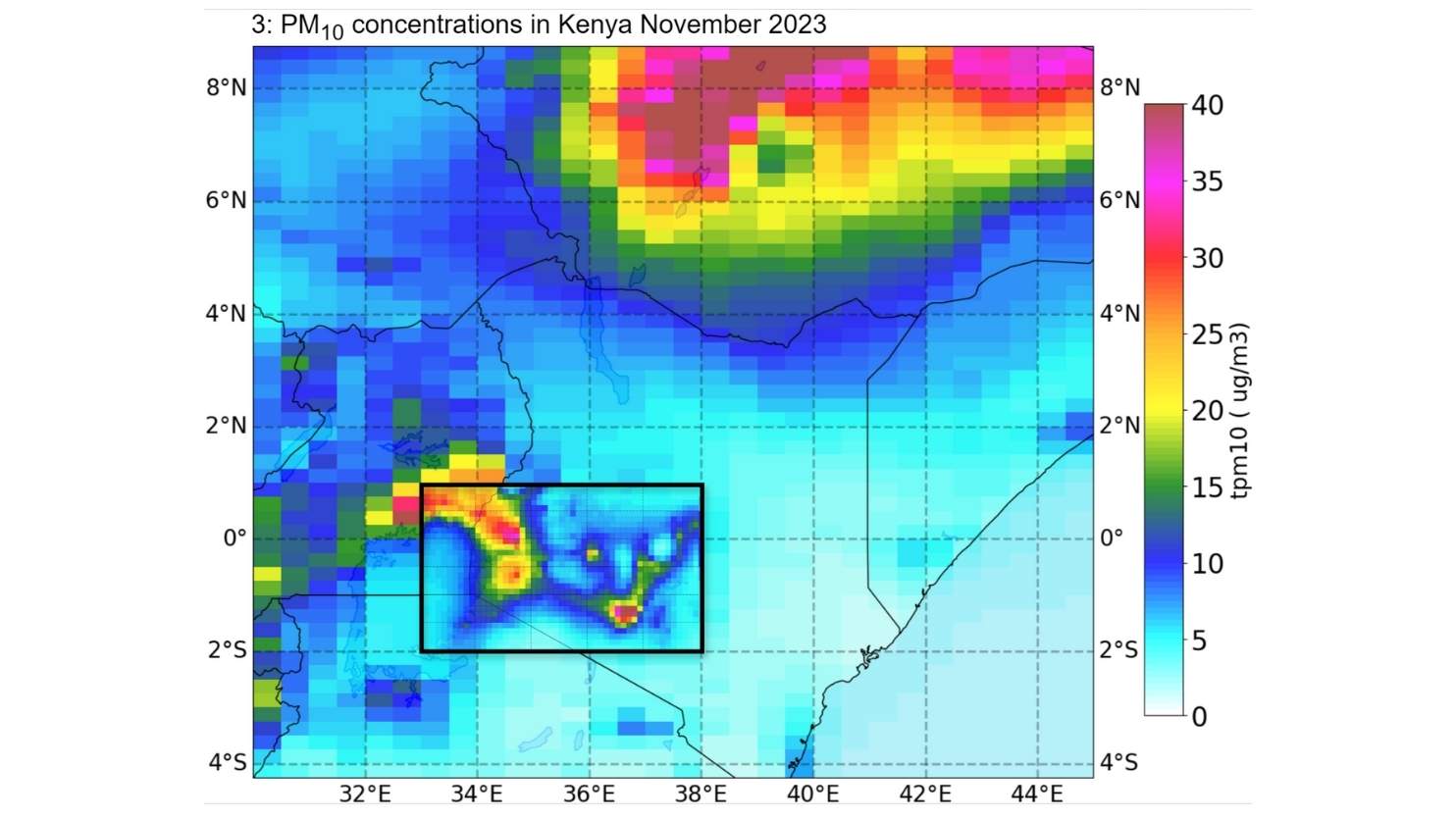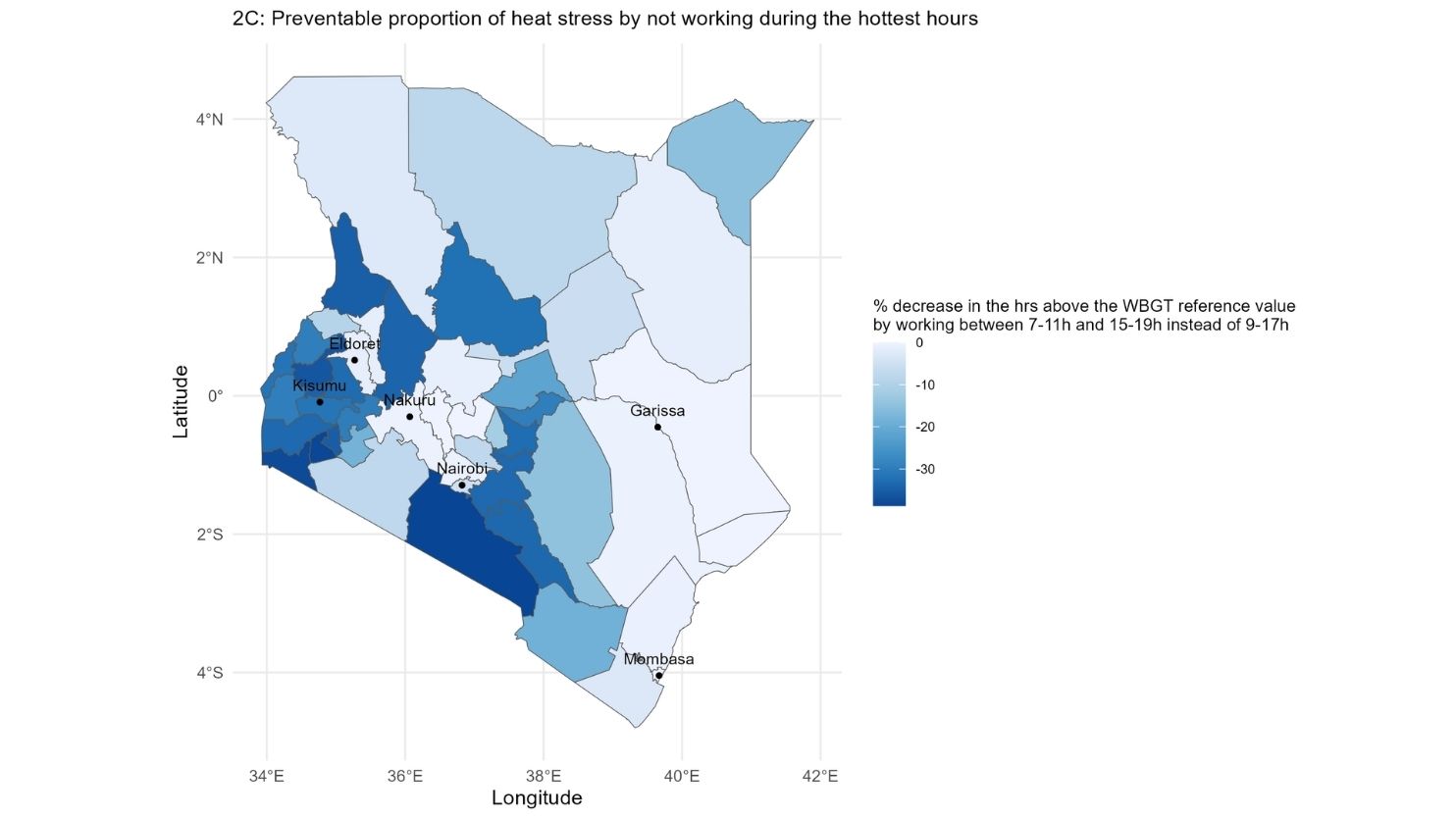A demonstration project in Kenya for heat stress and air quality modelling
As global temperatures rise, so do heat exposure and the associated health risks. Predicting what the effects will be is complex, as temperature is not the only factor - climate-related elements such as air pollution also play a significant role. Effective climate adaptation policies therefore require an integrated approach. In a case study conducted in Kenya, TNO combined various quantitative models to systematically map the risks of heat stress and air pollution exposure.
The complete picture
TNO collaborated with the Kenya Medical Research Institute (KEMRI), the Air Pollution Center of Excellence (APCE) at KEMRI, and the Clean Air Africa Center to develop a prototype for assessing exposure to heat and air pollution. The degree of heat stress was modeled based on meteorological data, as well as personal and task-dependent factors. The air quality information derives from TNO’s chemical transport modelling. This proof of concept was funded by the Dutch Ministry of Health, Welfare and Sport.
Using the modelled quantitative data, maps were created to illustrate the potential levels of exposure to heat stress and air pollution across different regions for various ‘vulnerable’ groups. The significance of these exposures was then assessed, considering individual characteristics, the use of protective clothing, and levels of physical exertion.
The project was selected by the World Health Organization (WHO) as an impactful and winning case study and was presented at the 2024 UN Climate Conference, COP29.
‘This innovative risk analysis of climate-related health risks in Kenya is a key contribution to the WHO’s Alliance for Transformative Action on Climate and Health (ATACH). More than 90 countries and regions within ATACH are committed to building climate-resilient health systems. Thanks to the case study developed by TNO, countries can now learn from the practical insights gained in Kenya—essential for advancing our collective efforts.’
Integrated approach essential for climate-related health risks
Climate change affects human health through a variety of interconnected factors, including extreme weather events, heat stress, air quality, water quality, and food security. Examining heat stress and air pollution together is a deliberate choice, not only because both are increasingly prevalent, but also due to their interactions.
Under certain conditions, heat stress and air pollution can amplify each other’s effects, making their combined impact greater than when considered separately. Anjoeka Pronk, an epidemiologist at TNO, explains: ‘When it’s hot, the body has to work harder to release heat, which increases metabolic activity. Then you breathe more deeply and may inhale more air pollution. It can also have a stronger effect under hot conditions.’
Additionally, air quality can intensify heat stress. In Kenya, for example, wood is commonly used for fuel, releasing fine soot particles into the air. These particles retain heat, increasing heat stress levels. Bas Henzing, Proposition Manager for Climate & Air Quality at TNO: ‘Our models allow us to quickly assess these interactions. There’s a lot to gain when you understand which component to target in order to reduce heat stress.’

Learning from and with each other
Yvette Fleming, Business Development Manager and Innovation Orchestrator at TNO: ‘A key pillar of this project is co-creation with Kenya’s entire ecosystem, using existing air quality monitoring data, meteorological data, European models, and TNO expertise.’ Collaboration included data collection, prototype development, and a strategy for disseminating results. The objective was to demonstrate that an integrated model can generate quantitative, action-oriented information for governments, businesses, civil society, and citizens—paving the way for sustainable climate adaptation strategies in Kenya.
Beyond sharing TNO’s expertise, the Netherlands can also learn a lot from Kenya. ‘For instance, in the Netherlands, we struggle to bridge the gap between the government and the public, where Kenya has a strong local approach,’ Bas Henzing explains. ‘In Kenya, journalists, local healthcare professionals, and policymakers all contribute to the same narrative.’
The first step towards a climate adaptation plan
To quantify heat stress, researchers used the Wet Bulb Globe Temperature (WBGT), which combines air temperature, humidity, solar radiation, and wind speed into a single index, similar to heat stress calculations. The models identify high-risk areas for heat stress and indicate when exposure risks peak. However, the actual risk varies per individual, as some people adapt better than others. Vulnerability depends on factors such as age, physical activity levels, underlying health conditions, pregnancy, clothing, and environmental adaptability.
By combining heat stress levels for different (vulnerable) groups with air quality data, it becomes possible to assess which groups face higher health risks during heatwaves. This provides insight into Kenya’s vulnerability to climate change and where climate change will have the most significant impacts—on people, the environment, society, the healthcare system, and the workforce, among others. A climate adaptation plan can only be developed once this vulnerability assessment is quantitatively established and scientifically validated.
In the long term, these models can also be used to predict the effects of different interventions quantitative - for example, how risk levels change when certain factors are adjusted. A Kenyan agricultural worker performing physical labour during the hottest part of the day, for instance, faces greater risk than if they were to rearrange their schedule to include rest or lighter tasks during peak heat hours.

Expanding to other countries
There is growing momentum for quantitative information on combined air quality and heat stress exposure as input for the national adaptation plans that all countries must develop under the UN Framework Convention on Climate Change. To support this, the WHO has developed guidelines on climate change and health. TNO’s unique multidisciplinary position - translating theory and field research into practice, combined with expertise in public-private partnerships and an ecosystem approach - plays a crucial role in this effort. Bas Henzing: ‘TNO offers the full package - covering everything from emissions and exposure to epidemiology and policy - all within a single institute. That’s truly unique.’
Join us
Measuring and monitoring air quality and heat stress, as well as understanding the impact of climate change on health, is an ongoing effort. We are currently collaborating with governments and organisations in Uruguay, Colombia, Chile, Croatia, Portugal, Germany, Southeast Asia, and Africa to develop routine monitoring and modelling practices. Do you have ideas, or would you like to contribute? Contact Bas Henzing, Anjoeka Pronk, or Yvette Fleming.
Get inspired
Women's health


Early metabolic health


TNO discovers new method to diagnose liver disease


A magic pill or personalised lifestyle medicine?


TNO research lays foundation for more reliable allergen information on food labels




